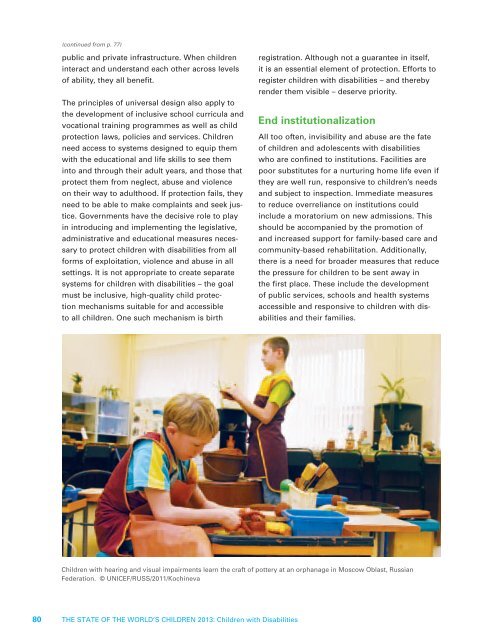State of the World's Children 2013 - Unicef
State of the World's Children 2013 - Unicef
State of the World's Children 2013 - Unicef
Create successful ePaper yourself
Turn your PDF publications into a flip-book with our unique Google optimized e-Paper software.
(continued from p. 77)<br />
public and private infrastructure. When children<br />
interact and understand each o<strong>the</strong>r across levels<br />
<strong>of</strong> ability, <strong>the</strong>y all benefit.<br />
The principles <strong>of</strong> universal design also apply to<br />
<strong>the</strong> development <strong>of</strong> inclusive school curricula and<br />
vocational training programmes as well as child<br />
protection laws, policies and services. <strong>Children</strong><br />
need access to systems designed to equip <strong>the</strong>m<br />
with <strong>the</strong> educational and life skills to see <strong>the</strong>m<br />
into and through <strong>the</strong>ir adult years, and those that<br />
protect <strong>the</strong>m from neglect, abuse and violence<br />
on <strong>the</strong>ir way to adulthood. If protection fails, <strong>the</strong>y<br />
need to be able to make complaints and seek justice.<br />
Governments have <strong>the</strong> decisive role to play<br />
in introducing and implementing <strong>the</strong> legislative,<br />
administrative and educational measures necessary<br />
to protect children with disabilities from all<br />
forms <strong>of</strong> exploitation, violence and abuse in all<br />
settings. It is not appropriate to create separate<br />
systems for children with disabilities – <strong>the</strong> goal<br />
must be inclusive, high-quality child protection<br />
mechanisms suitable for and accessible<br />
to all children. One such mechanism is birth<br />
registration. Although not a guarantee in itself,<br />
it is an essential element <strong>of</strong> protection. Efforts to<br />
register children with disabilities – and <strong>the</strong>reby<br />
render <strong>the</strong>m visible – deserve priority.<br />
End institutionalization<br />
All too <strong>of</strong>ten, invisibility and abuse are <strong>the</strong> fate<br />
<strong>of</strong> children and adolescents with disabilities<br />
who are confined to institutions. Facilities are<br />
poor substitutes for a nurturing home life even if<br />
<strong>the</strong>y are well run, responsive to children’s needs<br />
and subject to inspection. Immediate measures<br />
to reduce overreliance on institutions could<br />
include a moratorium on new admissions. This<br />
should be accompanied by <strong>the</strong> promotion <strong>of</strong><br />
and increased support for family-based care and<br />
community-based rehabilitation. Additionally,<br />
<strong>the</strong>re is a need for broader measures that reduce<br />
<strong>the</strong> pressure for children to be sent away in<br />
<strong>the</strong> first place. These include <strong>the</strong> development<br />
<strong>of</strong> public services, schools and health systems<br />
accessible and responsive to children with disabilities<br />
and <strong>the</strong>ir families.<br />
<strong>Children</strong> with hearing and visual impairments learn <strong>the</strong> craft <strong>of</strong> pottery at an orphanage in Moscow Oblast, Russian<br />
Federation. © UNICEF/RUSS/2011/Kochineva<br />
80<br />
THE STATE OF THE WORLD’S CHILDREN <strong>2013</strong>: <strong>Children</strong> with Disabilities

















